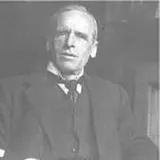
Ernest Starling (1866 -1927)
Biography
Hormones and the ‘law of the heart’
Ernest Starling’s interests in the mammalian heart and circulation developed while he was working at Guy’s Hospital in the late nineteenth century. His connection with King’s began with his schooling at King’s College School (then a junior department of the College) and medical studies at Guy’s Hospital. He became a demonstrator in the department of physiology at Guy’s and was made head of the department in 1889.
In 1902, Starling discovered secretin. He wrote the first description of a chemical substance produced in one part of the body that could circulate in the blood and produce a specific response elsewhere in the body, and coined the term ‘hormone’ for such substances.
Starling is best known to clinicians and physiologists for his ‘law of the heart’: ‘the energy of contraction is function of the length of the muscle fibres’. This physiological concept still influences clinical management of patients with congestive heart failure.
Starling also carried out innovative studies on the electromotive force of the mammalian heart and made fundamental observations about lymph and the peripheral circulation, showing that lymph resulted from intercapillary pressure and permeability of the capillary wall and was controlled by blood pressure and osmosis.
